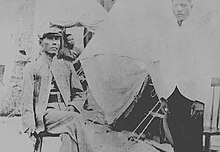Detention and later release
An initial group of more than thirty leaders of Philippine Revolution, including Pio del Pilar and Apolinario Mabini were transported to Guam aboard the SS Rosecrans. Guam's governor, Seaton Schroeder, was unprepared for their arrival, and they remained aboard ship in Apra Harbor. A week later, on February 1, 1901, the USS Solace arrived with eleven more deportees, who were transferred to join the others on the Rosecrans while a three-acre site between Piti and Hagåtña, was razed and the construction of the Presidio (prison) de Asan began. [4]

On February 12, 43 prisoners and 15 servants disembarked at Piti and trekked for two miles to Asan, where they were initially housed under guard in tents. Construction of the prison was completed on March 22. Prison facilities included exercise equipment, a small library, a dining room, and a kitchen separated from the prison barracks run by servants. Each prisoner was assigned 28 square feet of floor space, an army cot, and shelf space for personal items. [4]
Most deportees agreed to take the U.S. oath of allegiance after some time in detention and were returned to the Philippines. Mabini and Ricarte were exceptions.
Mabini refused to take the oath until February 1903, when he was formally notified that he could leave Guam to go anywhere other than the Philippines. On On February 26, 1903, rather than accept this, he took the oath in order to be allowed to return. He he issued this statement to the press on the day he sailed: [5]
After two long years I am returning, so to speak, completely disoriented and, what is worse, almost overcome by disease and sufferings. Nevertheless, I hope, after some time of rest and study, still to be of some use, unless I have returned to the Islands for the sole purpose of dying.
Mabini died at the age of 38 on May 13, 1903, less than three months after his return from exile. [5]
Ricarte never took the oath. He was deported to Hong Kong in February 1903 and secretly returned to the Philippines in 1904. After being arrested and imprisoned, he was again deported to Hong Kong in 1910. He moved to Japan, living in Yokohama and returning to the Philippines in mid 1942, while the Philippines was under wartime Japanese rule. [6]

